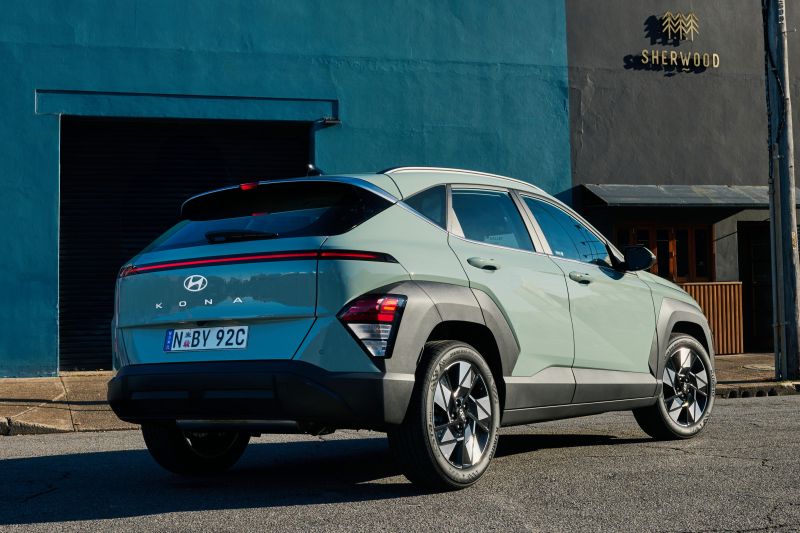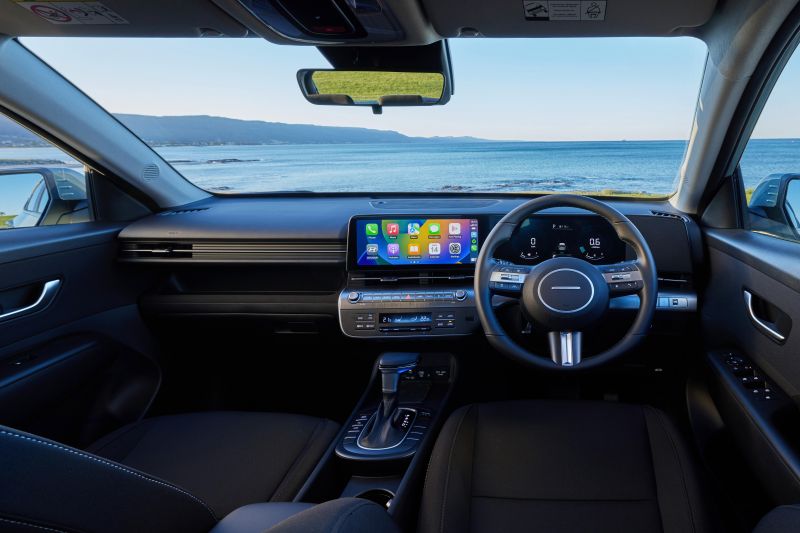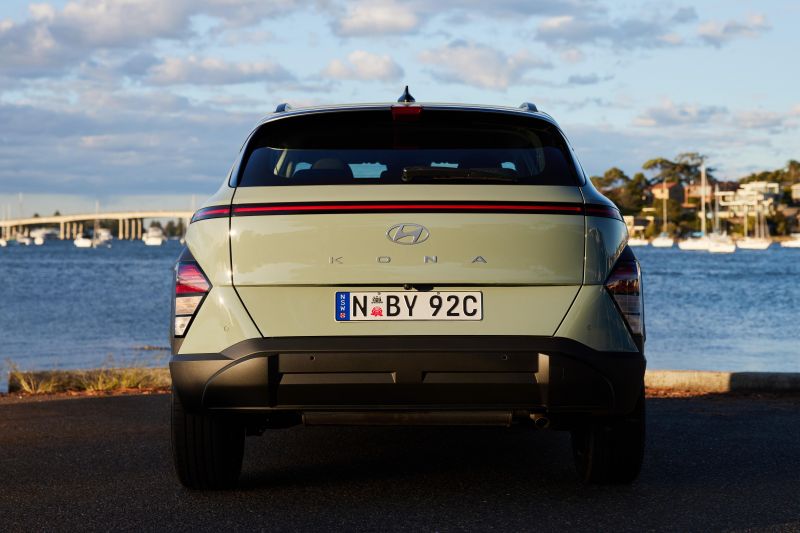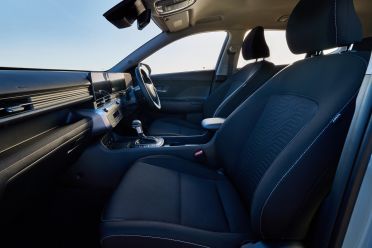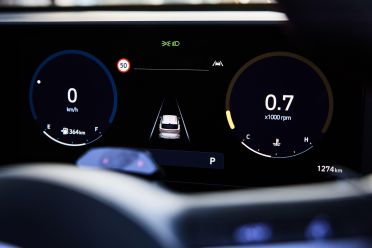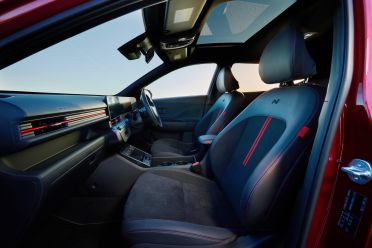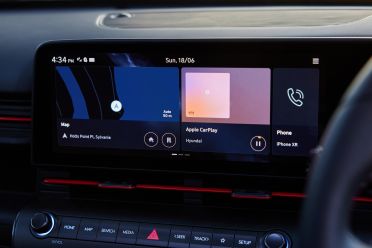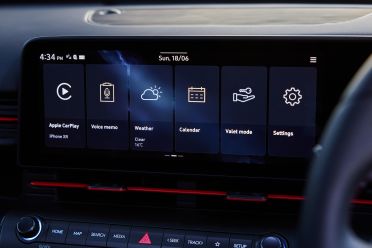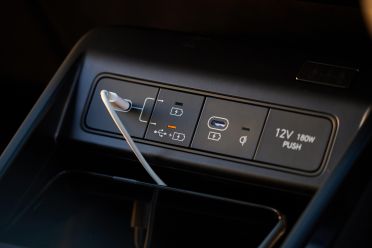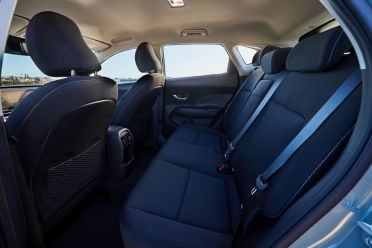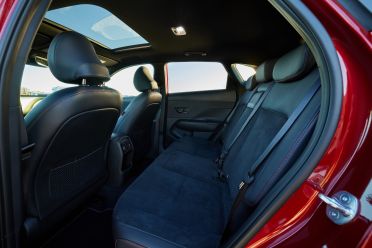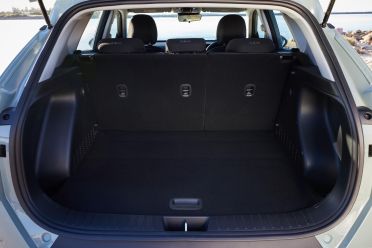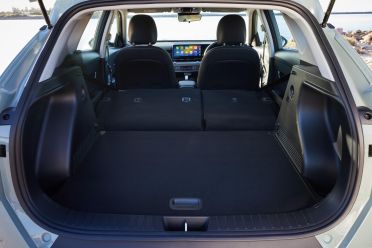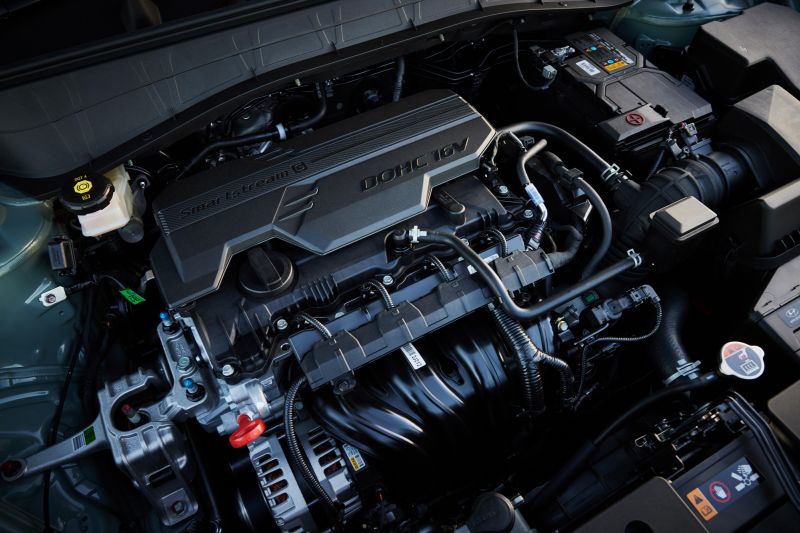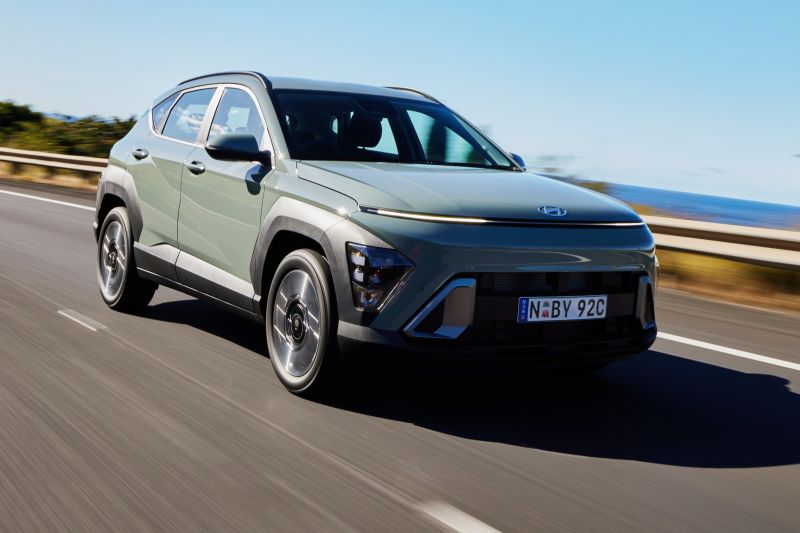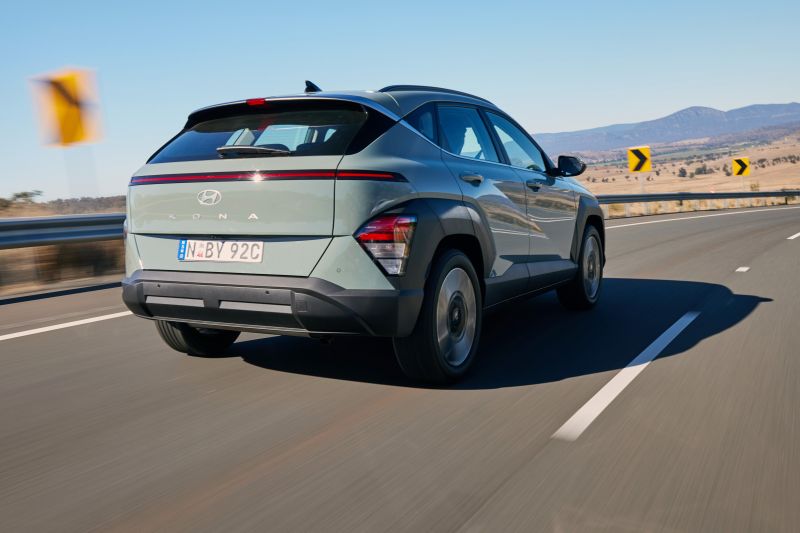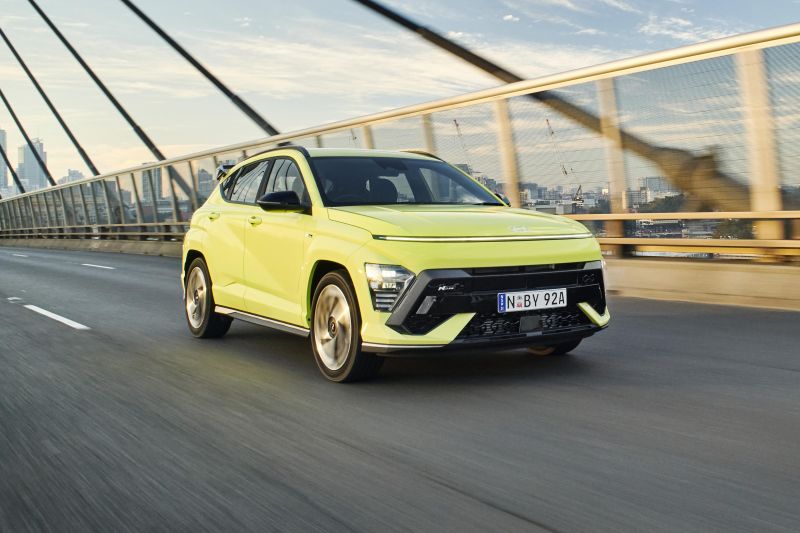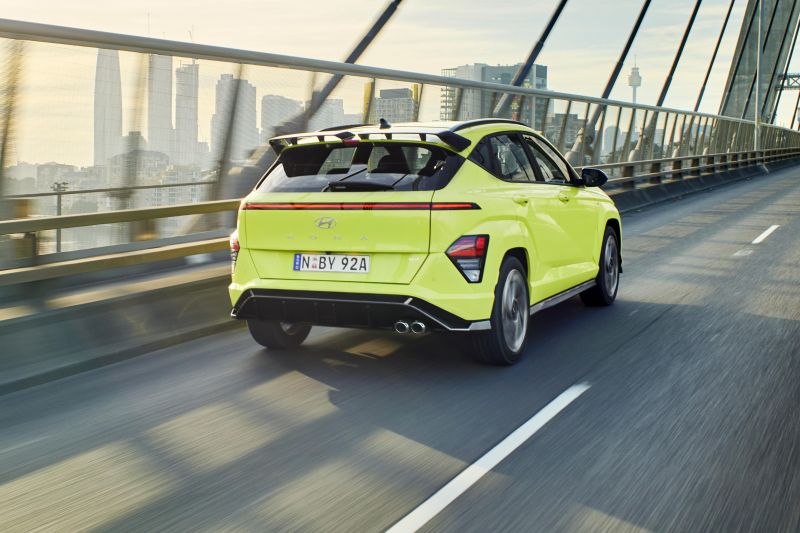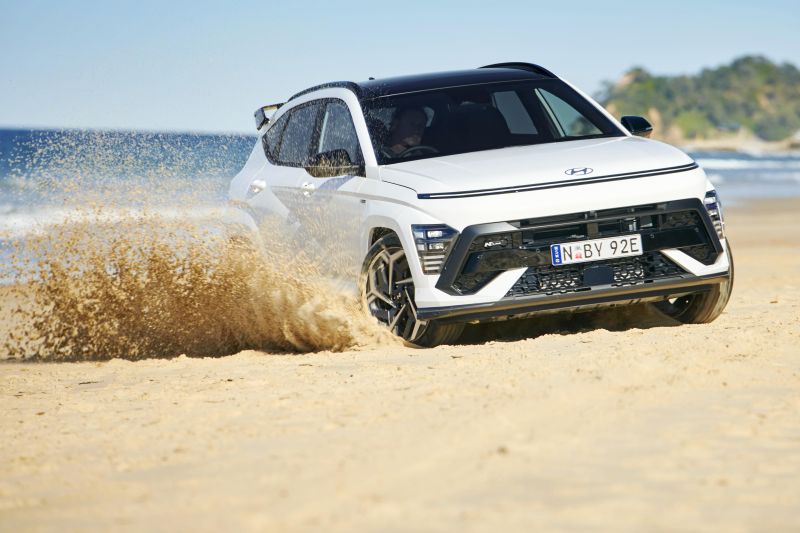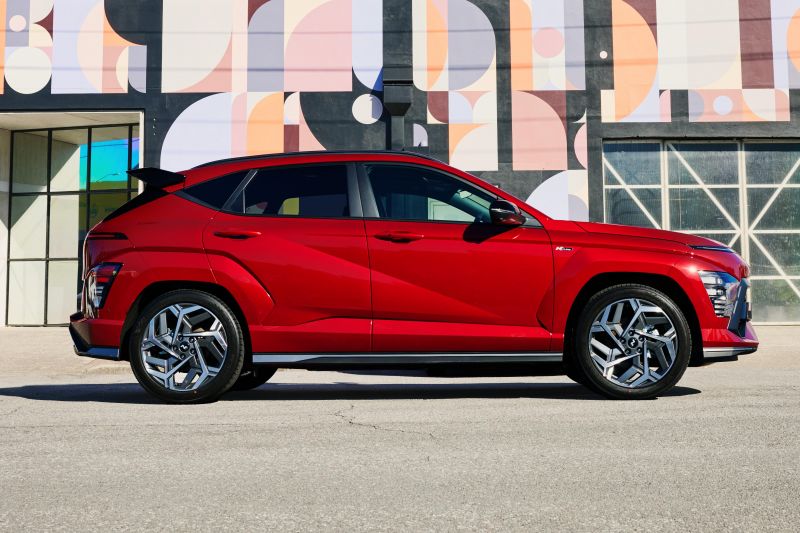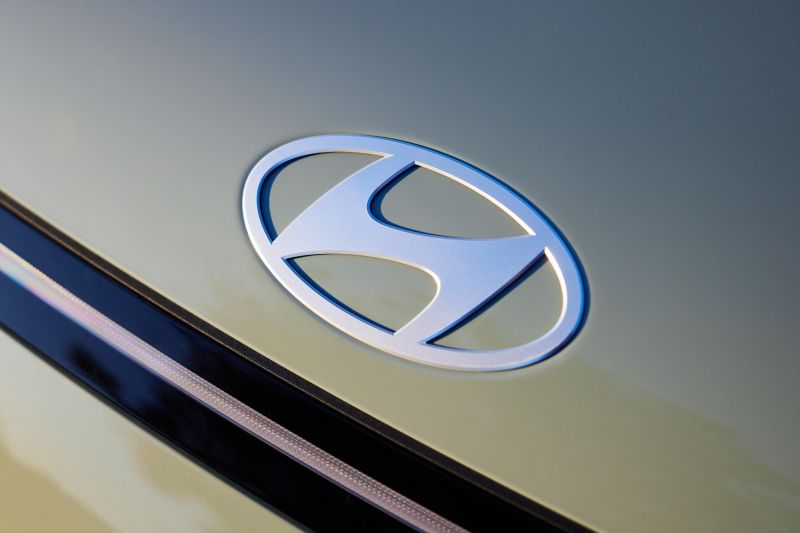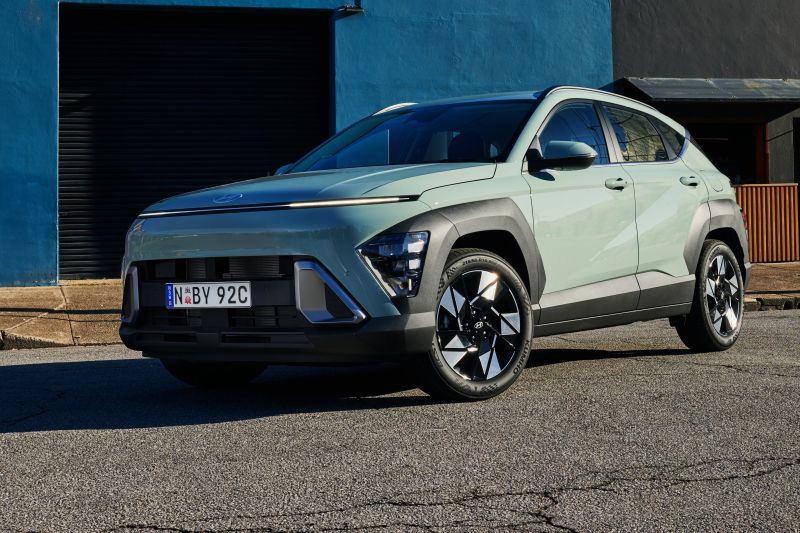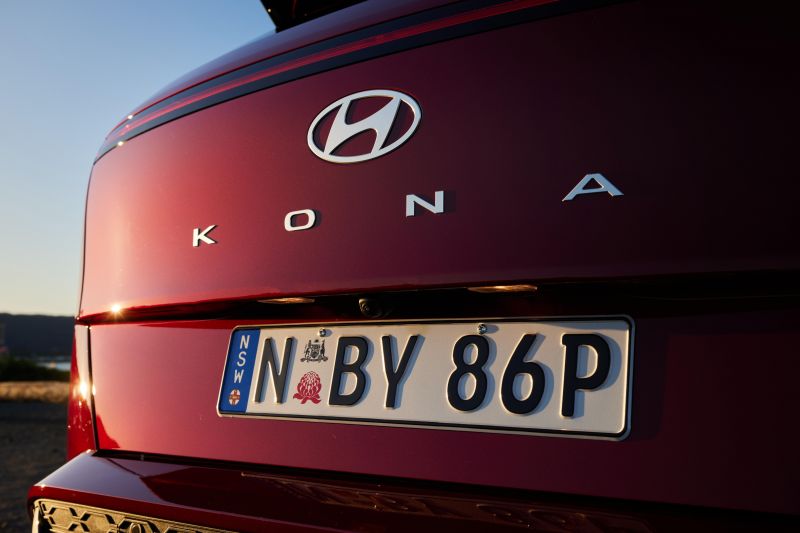
[ad_1]
The Hyundai Kona is again, greater than ever.
Though it solely launched in Australia in 2017, the Kona is a stalwart in one of many nation’s best-selling SUV segments – but it surely’s one which has quickly been made to look a bit quaint by newer rivals.
From the larger Kia Seltos and the extra luxurious Mazda CX-30, to the hybrid-powered Toyota Corolla Cross, the sport has modified and the Kona was getting left behind.
That’s the place the second-generation mannequin you see right here is available in. It’s greater in each dimension to raised battle the Seltos, encompasses a extra fashionable inside to raised battle the CX-30, and packs a hybrid to tackle the – you guessed it – Corolla Cross.
It’s greater than only a box-checking train. Though a few of the key particulars have been reimagined to raised cowl off a recent crop of opponents, the brand new Kona options an angular design that builds on the inspiration laid down by the funky first-generation automobile.
It additionally debuts a brand new infotainment system for Hyundai, full with the flexibility to wirelessly settle for software program updates all through its life.
There’s a little bit of floor to cowl right here.
How a lot does the Hyundai Kona price?
Pricing is up throughout the board for the brand new Hyundai Kona. The entry-level mannequin is $5100 dearer than the automobile it replaces, whereas on the prime finish the N Line Premium is $3300 pricier than the mannequin it replaces.
It now begins at $32,000 earlier than on-road prices for the entry-level petrol, climbing $46,500 plus on-roads for the flagship N Line Premium with both 1.6 Hybrid FWD or 1.6T AWD drivetrains.
Even within the context of the worth hikes hitting most autos in Australia, that’s vital – though Hyundai defends it by arguing the brand new automobile is larger and higher outfitted than earlier than.
On the backside finish, it’s aligned with a Kia Seltos Sport ($32,700) and Toyota Corolla Cross GX 2WD ($33,980 ).
On the prime finish, it goes head-to-head with the Seltos GT-Line ($44,900) and Corolla Cross Atmos 2WD Hybrid ($47,030), together with the Nissan Qashqai Ti ($47,390) – all costs exclude on-road prices.
2023 Hyundai Kona pricing:
- Hyundai Kona
- 2.0 FWD: $32,000
- 1.6 Hybrid FWD: $36,000
- Hyundai Kona N Line
- 1.6 Hybrid FWD: $40,000
- 1.6T AWD: $40,000
- Hyundai Kona Premium
- 2.0 FWD: $39,500
- 1.6 Hybrid FWD: $43,500
- Hyundai Kona N Line Premium
- 1.6 Hybrid FWD: $46,500
- 1.6T AWD: $46,500
All costs exclude on-road prices.
What’s the Hyundai Kona like on the within?
The most important difficulty with the final Kona was an absence of area inside. The brand new mannequin resoundingly addresses the issue.
It seems to be and feels considerably extra grown up up entrance, and there’s lastly sufficient room within the rear to comfortably carry adults behind adults. Just like the Kia Seltos and newest Nissan Qashqai, it feels extra like a smaller mid-sized SUV than a grown-up compact.
It’s additionally way more fashionable up entrance, with a model of the dual-screen show rolling out throughout the Kia and Hyundai ranges. Even base vehicles get a high-resolution 12.3-inch central show and a smartly-integrated ‘fundamental’ digital speedo, whereas higher-end fashions have twin 12.3-inch screens.
Presentation is spectacular throughout the vary. The clear design seems to be flashy, and options like dual-zone local weather management even on base fashions go some method to justifying a part of the worth rise.
The flip aspect? There’s nonetheless a lot of low-cost, onerous plastics, from the edges of the dashboard to the highest of the doorways.
Base fashions function a T-bar shifter and an open centre console with first rate space for storing, however shifting up the vary will get you an e-shifter on the steering column that frees up a wide-open centre tunnel that calls to thoughts the electrical Ioniq vary.
The view over the broad bonnet is extra commanding than earlier than, and it’s simpler than ever for taller drivers to get snug.
Hyundai’s newest expertise is a step ahead, with flashy graphics, easy menus, and a full function set. It’s additionally the primary to get touches for right-hand drive like shortcut buttons on the right-hand aspect of the display, in simple attain, relatively than hidden away on the top-right nook.
Base fashions with out satellite tv for pc navigation get wi-fi Apple CarPlay, and it’s coming to higher-end fashions with navigation later this 12 months – lastly. It’ll be obtainable for anybody who collects their automobile earlier than the rollout, doubtlessly with an over-the-air replace.
Though the fundamental dials are neat sufficient, the digital sprint supplied in higher-end fashions does liven the cabin up. Within the N Line, flicking into Sport provides you a red-and-white kerb define across the rev counter and speedo… though we’d nonetheless wish to see extra customisation potential, as is obtainable in Volkswagen Group merchandise.
Rear seat area is miles higher on this Kona than the final, beginning with the wider-opening doorways.
Adults don’t have to contort themselves to squeeze in anymore, which is a step ahead, and as soon as again there you get ranges of legroom and headroom corresponding to a Kia Seltos.
The air vents and USB-C ports are family-friendly touches, and the broader rear bench will preserving warring children at bay extra successfully than earlier than.
ISOFIX on the outboard seats and a trio of top-tether factors are current, as is a fold-down central armrest.
Boot area within the Kona has improved from 374L to 407L with the arrival of the bigger new second-generation automobile right here. With the rear seats folded there’s 1241L of area.
It’s a way more usable area than earlier than, with a height-adjustable ground and a slot in the back of the boot to retailer the bags cowl.
What’s underneath the bonnet?
The entry-level engine within the Kona stays a 2.0-litre naturally-aspirated four-cylinder petrol making 110kW of energy and 180Nm of torque.
It runs the extra environment friendly Atkinson Cycle, and is mated with a CVT – recognized within the Hyundai world as an IVT – with eight digital steps.
New for Australia is the choice of a hybrid powertrain within the Kona Hybrid. It combines a 1.6-litre naturally-aspirated petrol engine with an electrical motor, hooked as much as a 1.32kWh battery pack.
The electrical motor makes 32kW of energy and 172Nm of torque; mixed system outputs are 104kW and 265Nm. It’s hooked as much as a six-speed dual-clutch transmission – you’ll discover the identical drivetrain within the associated Kia Niro HEV, in addition to the upcoming Hyundai i30 Sedan Hybrid.
The range-topping 1.6-litre turbocharged four-cylinder petrol makes 146kW of energy and 265Nm of torque, mated with an eight-speed torque converter computerized. Gone is the previous seven-speed DCT.
Claimed gasoline economic system within the base 2.0L petrol is 6.6 litres per 100km on the mixed cycle. That jumps to 7.6L/100km within the 1.6L turbo, and drops to a thrifty 3.9L/100km within the hybrid.
How does the Hyundai Kona drive?
There’s a definite distinction between the bottom Kona and the 1.6-litre turbo.
We began within the base mannequin, which instantly thwacked and thumped its manner down a few of Sydney’s worst roads in chilly, moist climate.
Not one of the best first impression – though the automobile settled down properly as soon as we’d moved away from tarmac that regarded prefer it’d not too long ago been shelled.
Hyundai says it’s put actual effort into refining the newest Kona, and there’s little doubt the entry-level engine is extra polished than earlier than. It’s quieter underneath mild masses, and the CVT is an efficient instance of the breed.
It doesn’t simply flare revs right away, as an alternative leaning on what restricted torque there’s earlier than doing a reasonably convincing impression of a torque converter, full with slurred shifts.
For all that Hyundai has improved, the two.0 nonetheless feels extra sufficient than standout. It’s happiest at metropolis speeds, the place it could slur round with out feeling too strained, however while you put your foot down it feels as if it’s working onerous.
Overtaking at freeway speeds takes a little bit of planning, and also you’ll have to be prepared to place up with a little bit of noise within the cabin.
If that’s not an issue, the Kona is in any other case nicely arrange for lengthy stints behind the wheel. It handles pimply Australian nation highways remarkably nicely, with an unruffled manner that conjures up critical confidence.
It tiptoes the tough tightrope between management and luxury remarkably nicely for a (comparatively) reasonably priced, (comparatively) compact SUV.
Transferring to the 1.6-litre turbo N Line with all-wheel drive brings a wholesome enhance in punch.
The on-paper enhancements (36kW and 85Nm) are felt instantly in the actual world, the place the N Line accelerates extra effortlessly – even while you squeeze the accelerator relatively than stamping on it.
The loss of life of the dual-clutch transmission – changed with an eight-speed torque converter – has made it friendlier on the town. The final N Line was susceptible to jerking off the road, and may very well be flummoxed for those who lifted off the throttle on the improper time.
This time round, it feels extra snug in stop-start site visitors.
Though it’s barely slower to shift on the transfer, Hyundai’s DCT was by no means as fast or intelligent as a Volkswagen unit anyway, so the loss isn’t as keenly felt.
The punchier powertrain is backed by a steering and suspension tune that makes the N Line really feel extra purposeful. It doesn’t go so far as the previous-generation Kona N, however there’s undoubtedly a sportier bent that may please eager drivers.
Given we don’t know if Hyundai will develop a correct Kona N for this era, anybody who desires extra would possibly want to start out seeking to the aftermarket to make your N Line a bit angrier.
Frequent to the entire vary is Hyundai’s suite of SmartSense energetic driver assists.
The adaptive cruise management does a very good job sustaining a spot to the automobile in entrance, and the lane-keeping help decisively nudges you again between the white traces for those who stray.
Hyundai’s lane-centring system, which extra actively controls the automobile’s place within the lane relatively than intervening while you stray, is a bit too hands-on for my liking, although.
The motive force consideration monitoring can also be susceptible to false positives, flashing while you truly are trying on the highway… which makes you look away. Extra refinement is required.
What do you get?
Kona highlights:
- 18-inch alloy wheels with 215/55 tyres
- LED headlights, daytime working lights
- LED tail lights
- Heated, power-folding exterior mirrors
- Keyless entry and begin
- Twin-zone local weather management
- Rear air vents
- 4.2-inch digital instrument show
- 12.3-inch infotainment touchscreen
- Wi-fi Apple CarPlay, Android Auto
- Bluelink related providers
Kona Premium provides:
- Blind Spot View Monitor
- AEB in reverse
- 3D surround-view digicam
- Aspect parking sensors
- Acoustic entrance windscreen
- Rear privateness glass
- Darkish gray cladding, silver skid plates
- LED dual-projector headlights
- LED entrance, rear indicators
- Energy tailgate
- 12.3-inch digital instrument cluster
- Satellite tv for pc navigation
- Bose 8-speaker premium sound
- Leather-based upholstery
- 10-way energy driver’s seat
- 8-way energy passenger seat
- Premium rest entrance seats
- Heated, ventilated entrance seats
- Heated steering wheel
- Heated rear seats
- Auto-dimming inside mirror
- Rain-sensing wipers
- Ambient lighting
N Line Bundle provides:
- Exterior
- N Line bumpers, skid plates, aspect skirts
- Gloss black rear spoiler
- N badging, wheel caps
- 19-inch wheels with 235/45 tyres (2.0 MPi)
- 18-inch alloy wheels (Hybrid)
- Chrome twin exhaust
- Black mirror caps, beltline
- Physique colored cladding
- Inside
- Leather-based/Alcantara trim
- N steering wheel
- Purple air vents, seat highlights
- Darkish metallic trim highlights
- Black headlining
- Alloy pedals
- Sports activities scuff plates
- 2.0 MPi extras:
- LED dual-projector headlights
- LED entrance, rear indicators
- Energy tailgate
- 12.3-inch digital instrument cluster
- Auto-dimming inside mirrors
- Rain-sensing wipers
Is the Hyundai Kona secure?
The brand new Kona hasn’t been crash-tested by Euro NCAP or ANCAP but.
Normal security tools contains:
- 7 airbags incl. front-centre airbag
- Autonomous Emergency Braking (AEB)
- Pedestrian, Bike owner detection
- Ahead, Reverse
- Driver consideration monitoring
- Blind-spot help
- Lane-keep help
- Parking sensors
- Protected exit warning
How a lot does the Hyundai Kona price to run?
The Hyundai Kona is backed by a five-year, unlimited-kilometre guarantee.
Upkeep will probably be required each 15,000 kilometres or 12 months within the 2.0-litre petrol and 1.6-litre hybrid, and each 10,000 kilometres or 12 months within the turbocharged petrol.
The primary 5 providers in each the two.0 and the 1.6T will set you again $399 every – though that’s good for 75,000km of motoring within the 2.0, and 60,000km within the 1.6T as a result of their completely different distance necessities.
CarExpert’s Tackle the Hyundai Kona
The brand new Hyundai Kona strikes on from its predecessor in plenty of key methods.
It’s greater inside and outside, and the powertrains on provide at launch have been polished relative to people who got here earlier than.
Though the seems to be gained’t be for everybody – particularly in tennis ball yellow – it additionally presents nicely in particular person. Hyundai and Kia are taking some calculated dangers with their newest designs, and that strategy has paid off right here.
What’s to complain about? Effectively, that additional area and polish comes at a value. Regardless of which manner you spin it, a $5000 hike on the backside finish of the vary hurts.
Should you can dig deeper into your pockets, you’re getting a way more resolved little SUV – a head-to-head with the Kia Seltos and Mazda CX-30 beckons…
Click on the photographs for the complete gallery
MORE: Everything Hyundai Kona
[ad_2]
